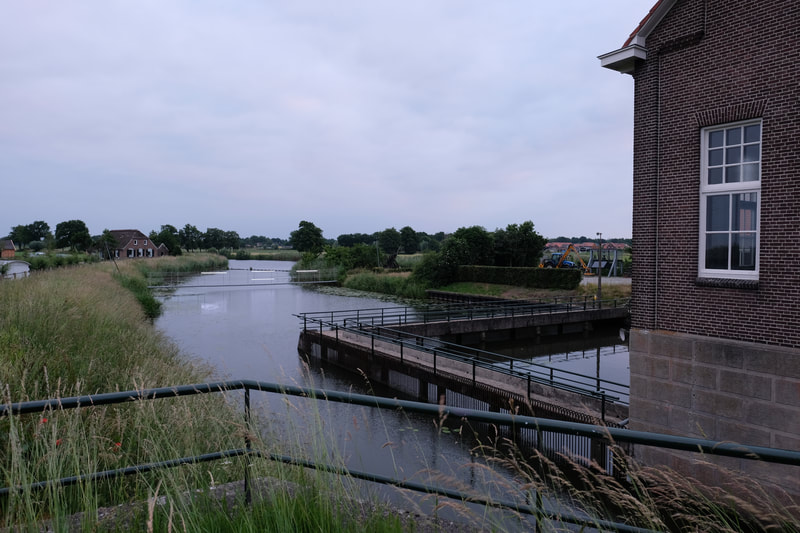Pouwel Bakhuis
IJsselbiënnale , 2021, Wapenveld, the Netherlands
Aluminium profiles, LED strips, controllers, computer, steel, speaker.
28 x 5 x 1,80 m.
|
Achter Gemaal Pouwel Bakhuis (gezien vanaf de Werversdijk nabij Wapenveld) bevindt zich een soort voetgangersbrug. Hier vandaan zie je, met de rug naar het gemaal gekeerd, een achttal (twee maal vier) horizontaal gespannen lijnen die evenwijdig lopen aan de brug. Wanneer je deze kunstinstallatie, want dat is het, in werking stelt, dan lichten delen van de draad afwisselend op tegen het achterliggende landschap. Ondertussen weerklinkt een compositie met viool en cello. Deze compositie is speciaal voor de kunstinstallatie gemaakt en gespeeld door studenten van het ArtEZ Conservatorium te Zwolle; Geert Jan Kroon (componist), Luis Rodriquez (violist) en Wisse (cellist).
De lijnen roepen, mede doordat ze op regelmatige afstand door verticale draden verbonden zijn, een associatie op met notenbalken. De horizontale gerichtheid van het transparante lijnenspel van het kunstwerk past bij het vlakke open landschap rond het gemaal en kan gekoppeld worden aan die titel van de IJsselbiënnale: TIJ, TIJD en TIJDELIJKHEID. Kunstenaar Peter Vink koos voor de muzikale compositie niet zomaar voor viool en cello. Want de naamgever van het gemaal, Pouwel Bakhuis, speelde samen met zijn broer Lammert cello en viool. Deze muzikale herenboeren woonden op een boerderij in het nabijgelegen Marle. Ooit zweefden op een mooie zomeravond de strijkklanken van hun cello en viool wellicht hier over de omringende velden en waterlopen. Dat is waar de twee maal vier draden naar verwijzen: de vier snaren van de viool en cello. Pouwel Bakhuis heeft veel betekend voor het waterschap dat dit gemaal in beheer heeft, vandaar dat het bouwwerk naar hem vernoemd is. Samen met het nabij gesitueerde gemaal Veluwe draagt gemaal Pouwel Bakhuis bij aan het waterbeheer in deze regio. De installatie van Peter Vink nodigt uit tot mijmeren en voegt subtiel een ragfijne visuele en auditieve laag aan het omringende landschap toe die heden en verleden verbindt. Laat je meedrijven met de tijdloze klanken en hypnotiseren door de oplichtende draden. ~ Het werk van Peter Vink zou in eerste instantie geplaatst worden bij het nieuwe Gemaal Veluwe. Peters inspiratie voor zijn werk kwam van het verhaal achter het oude Gemaal Pouwel Bakhuis en dus paste de locatie wijziging als gegoten. |
Behind the Pouwel Bakhuis pumping station (seen from the Werversdijk near Wapenveld) is a footbridge. From here, with your back turned to the pumping station, you can see eight (two times four) horizontally stretched lines that run parallel to the bridge. When you activate this art installation, parts of the wire alternately light up against the surrounding landscape. Meanwhile, a violin and cello composition resounds. This composition was made especially for the art installation and played by students of the ArtEZ Conservatory in Zwolle: Geert Jan Kroon (composer), Luis Rodriquez (violinist) and Wisse (cellist).
The lines evoke an association with music staves, partly because they are connected at regular intervals by vertical wires. The horizontal orientation of the transparent lines of the installation fits in with the flat open landscape around the pumping station and can be linked to the theme of the IJssel Biennial 2021: TIDE, TIME and TIMELESS. Artist Peter Vink did not choose violin and cello for the musical composition at random. For the namesake of the pumping station, Pouwel Bakhuis, played the cello and violin together with his brother Lammert. These musical gentleman-farmers lived on a farm in nearby Marle. Once upon a time, on a beautiful summer's evening, the string sounds of their cello and violin might have floated over the surrounding fields and watercourses. That is what the two times four wires refer to: the four strings of the violin and cello. Pouwel Bakhuis has meant a lot to the water authority that manages this pumping station, which is why the building is named after him. Together with the nearby Veluwe pumping station, Pouwel Bakhuis contributes to water management in this region. Peter Vink's installation invites you to contemplate and subtly adds a refined visual and auditory layer to the surrounding landscape, connecting past and present. Let yourself be carried away by the timeless sounds and hypnotised by the illuminating threads. ~ Peter Vink's work was initially intended for placement near the new Veluwe pumping station. Peter's inspiration for his work came from the story behind the old Pouwel Bakhuis pumping station, so the location was a perfect fit. |








